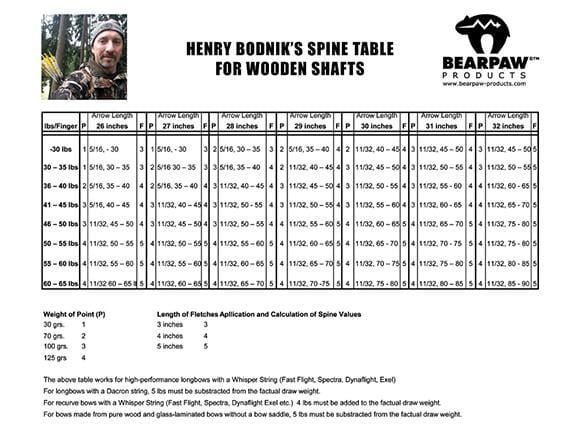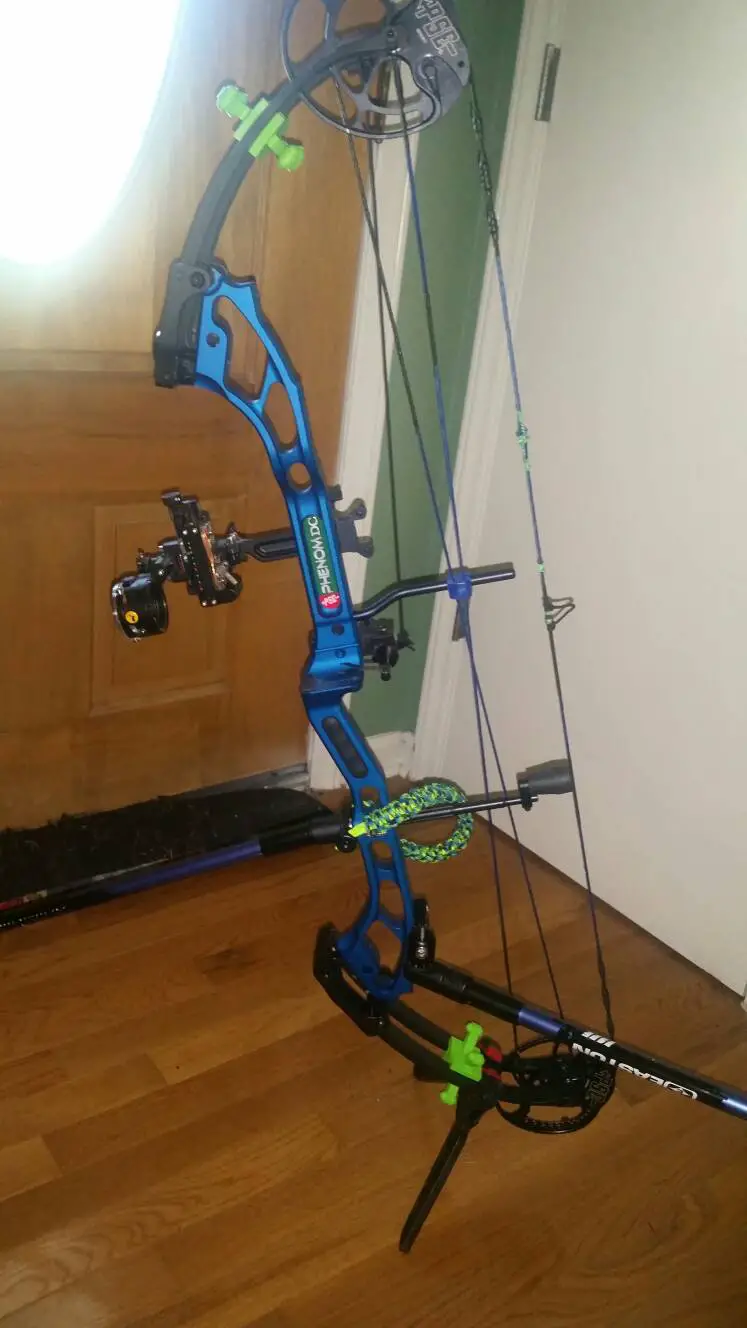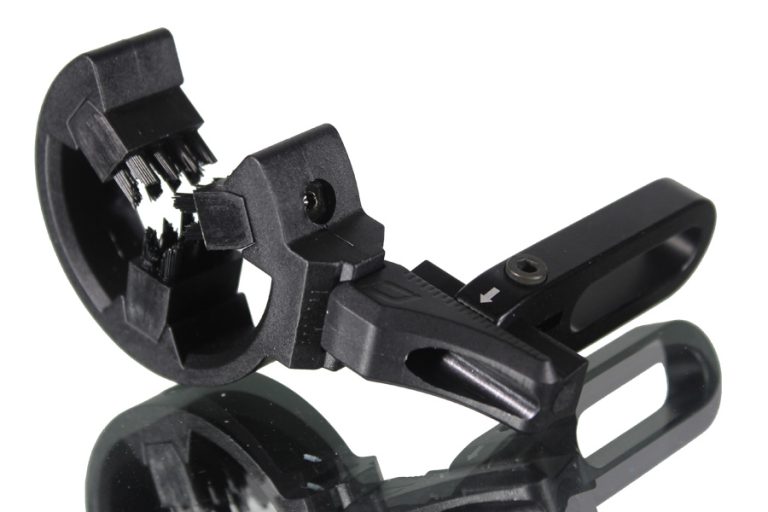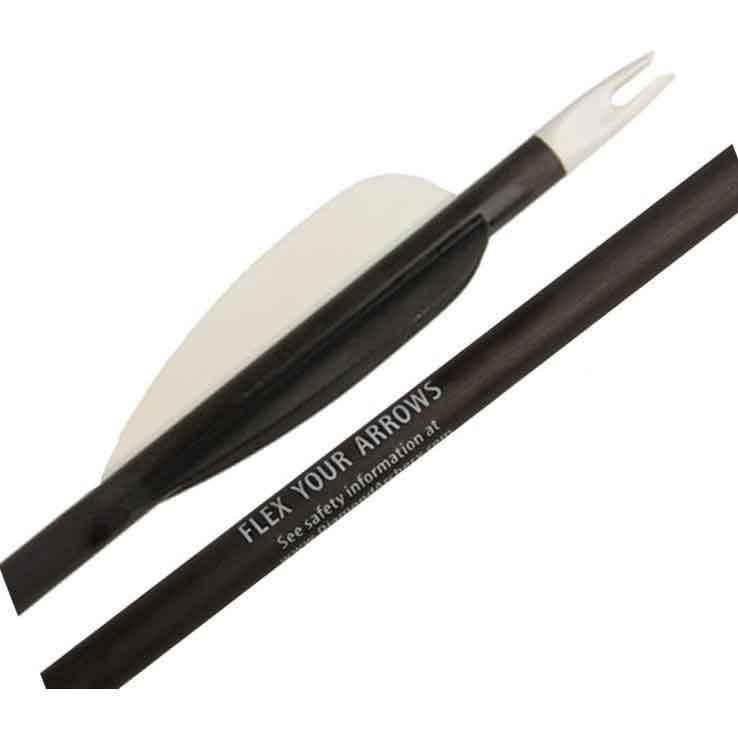Wood Arrow Spine Chart
In the fascinating world of archery, the compound bow stands as a remarkable fusion of innovation and tradition. With its intricate system of cables, pulleys, and cams, this modern marvel combines age-old principles with cutting-edge technology. This guide is here to unravel the mechanics, advantages, and appeal of compound bows. From the power and speed they generate to their compact design and adjustability, these bows have become the preferred choice for many archers. Whether you’re a seasoned pro or just starting out, the compound bow offers an exhilarating experience that combines the best of both worlds.
Wood Arrow Spine Chart
When it comes to archery, understanding arrow spine is crucial for achieving accurate and consistent shots. The wood arrow spine chart is a valuable tool that helps archers select the right arrow spine for their specific setup. In this comprehensive guide, we will explore what arrow spine is, why it is important, the factors affecting arrow spine, how to read and interpret an arrow spine chart, and ultimately, how to choose the right arrow spine for your bow.

1. What is Arrow Spine?
Arrow spine refers to the stiffness of an arrow shaft. It determines how much the arrow bends when it is shot from the bow. The spine of an arrow is influenced by factors such as the bow’s draw weight, arrow length, arrow point weight, the archer’s draw length, release technique, and bow style. An arrow with the correct spine will fly straight and true, while an incorrect spine can lead to inconsistencies and poor accuracy.
2. Importance of Arrow Spine
Having the right arrow spine is crucial for several reasons. First and foremost, it affects the accuracy of your shots. Arrows that are too weak or too stiff can result in erratic flight paths and inconsistent grouping. Secondly, arrow spine affects energy transfer from the bow to the arrow. If the arrow spine is mismatched, energy is wasted, and the overall performance of the bow is compromised. Lastly, the correct arrow spine ensures optimal arrow clearance, reducing the risk of contact between the arrow and bow components during the shot.
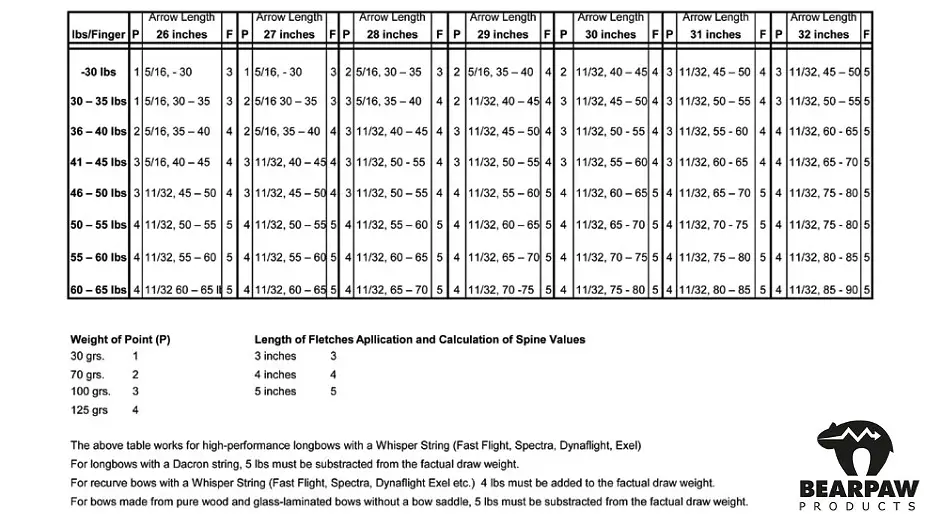
3. Factors Affecting Arrow Spine
Several factors influence arrow spine. Understanding these factors is essential for selecting the appropriate shaft stiffness for your specific setup. Let’s take a closer look at each of these factors:
3.1. Bow Draw Weight
The draw weight of your bow is perhaps the most significant factor affecting arrow spine. Draw weight refers to the force required to pull the bowstring back to its full draw length. A bow with higher draw weight requires a stiffer arrow shaft to handle the increased force, while a bow with lower draw weight needs a more flexible arrow.
3.2. Arrow Length
The length of the arrow also plays a role in determining its spine. Longer arrows tend to flex more, requiring a stiffer shaft to maintain proper flight. Conversely, shorter arrows will bend less and typically require a more flexible arrow shaft.
3.3. Arrow Point Weight
The weight of the arrow point, or the broadhead, affects arrow spine as well. Heavier points can make the arrow behave stiffer, while lighter points can make it behave weaker. It is crucial to consider the weight of the point when choosing an arrow shaft.
3.4. Archer’s Draw Length
An archer’s draw length, or the distance they pull the bowstring back, is another factor that influences arrow spine. Longer draw lengths put more force on the arrow, often requiring a stiffer shaft. Conversely, shorter draw lengths typically require a more flexible shaft.
3.5. Archer’s Release Technique
The release technique employed by the archer can also impact arrow spine. The way an archer releases the string can either add or decrease stress on the arrow, affecting its behavior in flight. Some release techniques may require a stiffer arrow shaft to compensate for the increased stress.
3.6. Archer’s Bow Style
Different bow styles, such as traditional recurve bows, longbows, and compound bows, have varying effects on arrow spine. Each bow style has different forces being exerted on the arrow, necessitating different spine requirements.
4. Understanding Arrow Spine Chart
The arrow spine chart is a valuable tool that simplifies the process of selecting the appropriate arrow spine. It provides a quick reference for matching the specific factors affecting arrow spine with the correct arrow shaft stiffness.
4.1. How to Read an Arrow Spine Chart
An arrow spine chart typically consists of columns representing different draw weights and rows representing different arrow lengths. Each cell of the chart indicates the recommended arrow spine for that specific combination of draw weight and arrow length. By locating your bow’s draw weight and your arrow length on the chart, you can determine the corresponding arrow spine value.
4.2. Interpreting Arrow Spine Values
Arrow spine values are often denoted in a numerical format such as 400, 500, or 600. The higher the number, the more flexible the arrow shaft. Conversely, lower numbers indicate stiffer arrow shafts. It is essential to choose an arrow spine value that matches your specific setup based on the recommendations provided in the arrow spine chart.
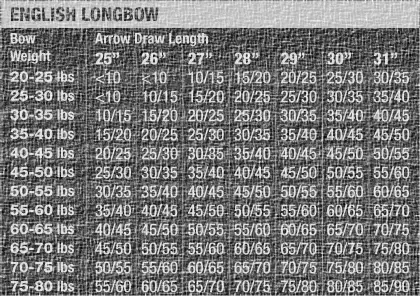
5. Choosing the Right Arrow Spine
To choose the right arrow spine for your bow, you need to consider the various factors we discussed earlier and follow a step-by-step process. Here’s a breakdown of the essential steps:
5.1. Determine Your Bow Draw Weight
Start by determining your bow’s draw weight. This can typically be found on the bow’s limb or in the owner’s manual. Make sure to use the actual draw weight, as modifications to the bow can affect the final weight.
5.2. Measure Your Draw Length
Next, measure your draw length accurately. Your draw length is the distance from the nock point to the throat of the grip, usually measured in inches. If you are unsure, consult a local archery shop or utilize online resources to determine your draw length accurately.
5.3. Consider Arrow Length
Take into account the desired arrow length for your shooting style or purpose. Longer arrows may require a stiffer shaft, while shorter arrows may require a more flexible one.
5.4. Factor in Point Weight
Consider the weight of your arrow point or broadhead. Heavier points often require a stiffer shaft, while lighter points may require a more flexible one.
5.5. Consult the Arrow Spine Chart
With all the necessary information at hand, consult the arrow spine chart that corresponds to your bow brand or arrow manufacturer. Locate your bow’s draw weight and arrow length on the chart, and identify the recommended arrow spine value. This value will guide you in selecting the appropriate arrow shaft.
6. Testing and Fine-Tuning
Selecting the recommended arrow spine value from the chart is a great starting point, but it is not the final step. Fine-tuning and testing are necessary to ensure optimal performance. Here are a few methods you can use to fine-tune your arrows:
6.1. Bareshaft Test
The bareshaft test involves shooting arrows without fletchings to assess their flight characteristics. By analyzing the impact point and the consistency of the arrows, you can make adjustments to the arrow spine if needed.
6.2. Paper Tuning
Paper tuning is a technique that involves shooting arrows through a sheet of paper to analyze the arrow’s flight. By examining the tear pattern on the paper, you can make adjustments to the arrow rest or spine to achieve straighter flight.
6.3. Broadhead Testing
If you plan to use broadheads for hunting, it is essential to test their flight characteristics as well. Different broadheads may behave differently in flight, so evaluating their performance will help ensure accuracy and consistency.
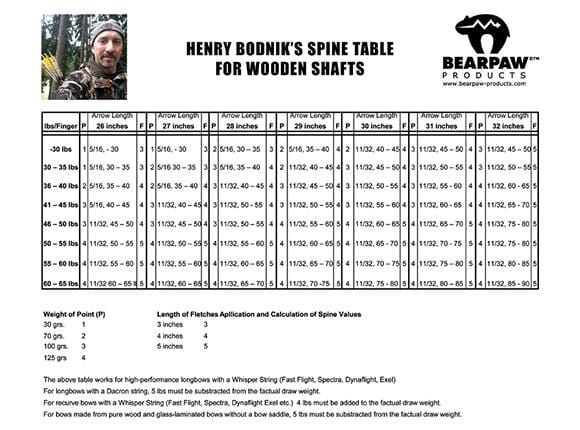
7. Common Mistakes to Avoid
When dealing with arrow spine, there are a few common mistakes that archers should be aware of to achieve optimal performance and accuracy.
7.1. Choosing an Incorrect Spine
One of the most common mistakes is selecting an incorrect arrow spine. It is crucial to use the arrow spine chart as a guide and choose the recommended spine value based on your bow’s draw weight and arrow length. Avoid guessing or assuming, as this can lead to inconsistent and inaccurate shots.
7.2. Ignoring Varied Shooting Conditions
Ignoring the influence of different shooting conditions on arrow spine can also lead to poor performance. Factors such as temperature, humidity, and elevation can affect arrow flight. It is essential to consider these variables and make adjustments as necessary.
7.3. Neglecting Proper Arrow Maintenance
Proper arrow maintenance is often overlooked but is essential for consistent performance. Regularly inspect your arrows for any signs of damage, ensure they are clean and free from debris, and replace worn-out components such as nocks or fletchings. Neglecting proper arrow maintenance can influence arrow spine and ultimately affect accuracy.
8. Other Considerations
While arrow spine is a critical factor in achieving accurate shots, there are other considerations to keep in mind when setting up your archery equipment.
8.1. Shaft Material
Arrow shafts can be made from different materials, such as wood, carbon, or aluminum. Each material has its characteristics, including weight, stiffness, and durability. Consider the advantages and disadvantages of each material before making a decision.
8.2. Fletching Style
Fletchings are the feathers or vanes attached to the back of the arrow shaft. They stabilize the arrow during flight. Different fletching styles offer varying degrees of stability and performance. Experiment with different fletching styles to find the one that suits your shooting style and arrow setup best.
8.3. Arrow Weight
The overall weight of the arrow can affect its flight characteristics. Heavier arrows often provide more stability and penetration, while lighter arrows may offer higher speed. Consider your shooting style, intended purpose, and the recommendations of your bow and arrow manufacturer when selecting arrow weight.
8.4. Archery Skill Level
Finally, consider your archery skill level when choosing arrow spine. Beginners may benefit from slightly more flexible arrows to forgive minor form and release mistakes. As your skill level improves, you can gradually transition to stiffer shafts that offer greater speed and accuracy.
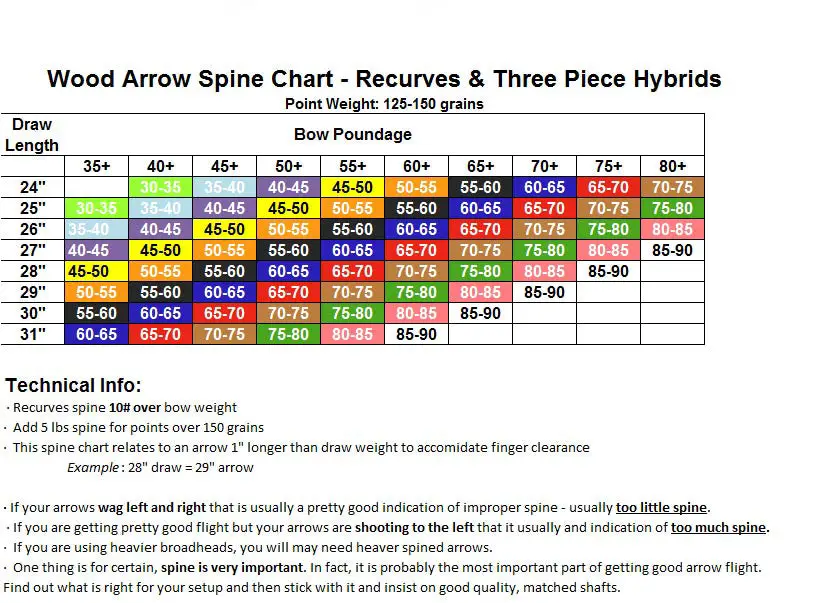
9. Conclusion
Selecting the right arrow spine is crucial for achieving accurate and consistent shots in archery. By understanding the factors influencing arrow spine and utilizing the wood arrow spine chart, archers can make informed decisions about their arrow setup. Remember to consider all the relevant factors, fine-tune and test your arrows, and avoid common mistakes to optimize your performance on the archery range or in the field. With the right arrow spine and a well-maintained setup, you’ll be well on your way to hitting the bullseye every time.

